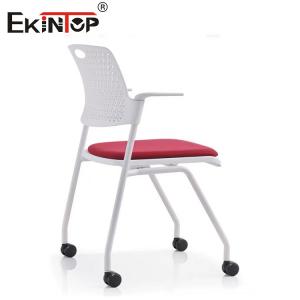
Add to Cart
Plastic Backrest with Iron Frame Foldable Training Chair with Casters
Product Description:
| Product Name | Plastic Backrest with Iron Frame Foldable Training Chair with Casters |
| Material: | Plastic and Fabric |
| Specific Use: | OFFICE CHAIR |
| Armrest: | Yes |
| Design Style: | Modern |
| Place of Origin | Guangdong, China, Guangdong, China (Mainland) |
Quick Details:
1.Aesthetics: Training chairs are available in a variety of designs and finishes to suit different training room aesthetics. They can range from simple and utilitarian styles to more contemporary or modern designs. Consider the overall look and feel of the training space when choosing chairs that complement the decor and create a cohesive environment.
2.Durability: Training chairs are built to withstand frequent use in high-traffic environments. They are often constructed with durable materials, such as metal frames or sturdy plastics. Look for chairs with reinforced joints and robust construction to ensure long-lasting durability.
3.Design: Training chairs are designed with functionality and flexibility in mind. They typically have a lightweight and compact design, making them easy to move, stack, and store. Many training chairs feature a simple and streamlined aesthetic that can blend well with various training room setups.
Features:
1.Quick Setup and Storage: Training chairs are often designed for easy setup and storage, allowing for efficient use of training spaces. They can be quickly arranged in rows or circles for lectures, presentations, or discussions. Additionally, their stackable or foldable design enables convenient storage when not in use, maximizing the available space in training rooms or allowing for flexible room configurations.
2.Integrated Storage Solutions: Some training chairs come with built-in storage options, such as under-seat compartments or pockets. These storage solutions provide a convenient place for participants to store personal belongings, training materials, or electronic devices. Integrated storage helps keep the training area organized and reduces clutter, enhancing the overall efficiency and functionality of the space.
3.Accessibility Features: Training chairs can be designed with accessibility in mind, ensuring that individuals with mobility challenges or disabilities can comfortably participate in training sessions. This may include features such as wider seats, armrests with easy-grip handles, or wheelchair-accessible designs. By incorporating accessibility features, training chairs promote inclusivity and equal participation for all trainees.
4.Cost-Effectiveness: Training chairs can offer a cost-effective seating solution for training facilities. Compared to individual desks and chairs, training chairs often provide a more economical option, especially for larger training rooms. Their space-saving design and durability contribute to long-term cost savings by reducing the need for frequent replacements or repairs.
Advantages:
1.Positive Learning Environment: Ultimately, the advantages of training chairs contribute to creating a positive learning environment. When participants are comfortable, engaged, and supported by the right seating, they are more likely to be attentive, participative, and retain information effectively. The design and features of training chairs play a crucial role in fostering a conducive and enjoyable training experience.
2.Safety Features: Training chairs prioritize safety by incorporating various features. These may include non-slip feet, stability mechanisms to prevent tipping, and fire-retardant materials. Safety features help create a secure environment for participants and minimize potential risks during training sessions.
3.Accessibility: Training chairs can be designed to accommodate individuals with disabilities or mobility challenges. Some chairs offer features like wider seats, armrests with additional support, or extra space for assistive devices. These accessibility features ensure that all participants can comfortably and inclusively engage in training activities.
4.Versatility: Training chairs are versatile and adaptable to various training settings. They can be used in classrooms, conference rooms, workshops, or seminar halls. Training chairs are available in different sizes, styles, and configurations to accommodate different training needs and preferences. Their versatility allows for seamless integration into different training environments.
5.Comfort and Ergonomics: Training chairs are designed with participant comfort in mind. They often feature ergonomic elements such as contoured seat cushions, lumbar support, and adjustable features like seat height and backrest tilt. These design elements promote proper posture, reduce strain on the body during long training sessions, and enhance overall comfort.

